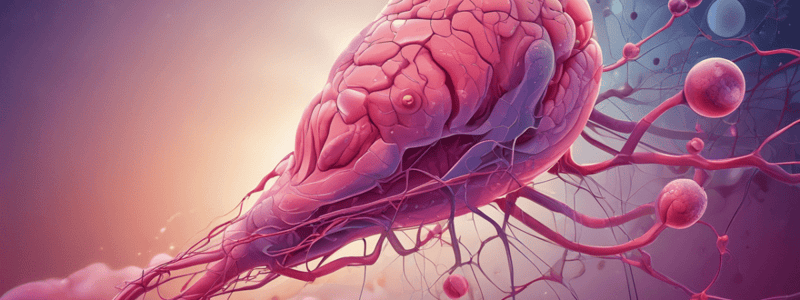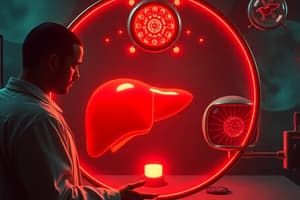Podcast
Questions and Answers
What percentage of total plasma proteins does globulin constitute?
What percentage of total plasma proteins does globulin constitute?
- 60%
- 50%
- 25%
- 38% (correct)
What is the primary function of albumin in maintaining blood pressure?
What is the primary function of albumin in maintaining blood pressure?
- Creation of oncotic pressure (correct)
- Buffering of acids and bases
- Transportation of hormones
- Regulation of blood pH
What happens when plasma albumin level decreases by 3 mg/dl?
What happens when plasma albumin level decreases by 3 mg/dl?
- Blood viscosity increases
- Immune response is triggered
- Edema occurs (correct)
- Fibrinogen levels increase
What percentage of lipids in plasma are transported by binding to plasma proteins as lipoproteins?
What percentage of lipids in plasma are transported by binding to plasma proteins as lipoproteins?
Which of the following is NOT a function of plasma proteins?
Which of the following is NOT a function of plasma proteins?
Which group of proteins is important in immune response?
Which group of proteins is important in immune response?
What is the term for the osmotic force created by plasma proteins?
What is the term for the osmotic force created by plasma proteins?
What is the percentage of plasma proteins constituted by fibrinogen?
What is the percentage of plasma proteins constituted by fibrinogen?
What type of anemia arises from folic acid deficiency?
What type of anemia arises from folic acid deficiency?
What is the process called when white blood cells pass from the vein to the tissue?
What is the process called when white blood cells pass from the vein to the tissue?
What is the term for an increase in the number of leukocytes?
What is the term for an increase in the number of leukocytes?
What is the function of erythrocytes?
What is the function of erythrocytes?
What type of leukocytes do not contain granules in their cytoplasm?
What type of leukocytes do not contain granules in their cytoplasm?
What is the approximate percentage of neutrophils in human blood?
What is the approximate percentage of neutrophils in human blood?
Where are leukocytes produced and stored?
Where are leukocytes produced and stored?
What is the term for the production of leukocytes?
What is the term for the production of leukocytes?
Which type of anemia is characterized by hypochromic and microcytic erythrocytes in a peripheral smear?
Which type of anemia is characterized by hypochromic and microcytic erythrocytes in a peripheral smear?
What is the main cause of aplastic anemia?
What is the main cause of aplastic anemia?
What is thalassemia?
What is thalassemia?
What is necessary for DNA construction?
What is necessary for DNA construction?
What is the characteristic of erythrocytes in pernicious anemia?
What is the characteristic of erythrocytes in pernicious anemia?
What can cause aplastic anemia?
What can cause aplastic anemia?
What is hemolytic anemia caused by?
What is hemolytic anemia caused by?
Why is thalassemia often seen in Mediterranean countries?
Why is thalassemia often seen in Mediterranean countries?
What is the primary function of serotonin released by platelets during the vasoconstrictive phase of hemostasis?
What is the primary function of serotonin released by platelets during the vasoconstrictive phase of hemostasis?
What is the primary role of the platelet plug in hemostasis?
What is the primary role of the platelet plug in hemostasis?
What is the significance of the basement membrane exposure to blood flow during the vasoconstrictive phase?
What is the significance of the basement membrane exposure to blood flow during the vasoconstrictive phase?
Which of the following is NOT a direct effect of thromboxane A2 released by platelets?
Which of the following is NOT a direct effect of thromboxane A2 released by platelets?
What is the role of calcium ions released by activated platelets during the coagulation phase?
What is the role of calcium ions released by activated platelets during the coagulation phase?
What is the approximate time delay between the vessel damage and the initiation of the coagulation phase?
What is the approximate time delay between the vessel damage and the initiation of the coagulation phase?
Which of the following events occurs FIRST during the vasoconstrictive phase?
Which of the following events occurs FIRST during the vasoconstrictive phase?
How does the platelet plug contribute to hemostasis?
How does the platelet plug contribute to hemostasis?
What is the main characteristic of leukemic cells?
What is the main characteristic of leukemic cells?
What is the average lifespan of platelets?
What is the average lifespan of platelets?
What do platelets primarily help prevent?
What do platelets primarily help prevent?
How are aging and expired platelets removed from the bloodstream?
How are aging and expired platelets removed from the bloodstream?
What is the role of platelets when a blood vessel is injured?
What is the role of platelets when a blood vessel is injured?
Which of the following statements about leukemia is true?
Which of the following statements about leukemia is true?
What kind of cells are platelets derived from?
What kind of cells are platelets derived from?
What is the primary function of hemostasis?
What is the primary function of hemostasis?
Flashcards are hidden until you start studying
Study Notes
Albumin and Edema
- Albumin production decreases in liver diseases such as cirrhosis
- 1g of albumin holds 18ml of water
- Edema occurs when plasma albumin level decreases by 3mg/dl
Globulin
- Constitutes 38% of total plasma proteins
- Plasma contains 2.3mg/dl of globulin
- Exists as lipoprotein, glycoproteins, and globulins
- Glycoproteins: most of glucose is transported in the form of glycoproteins
- Globulins: important carrier for lipids and polysaccharides; 75% of all lipids in plasma are transported by binding to plasma proteins as lipoproteins
- Transferrin, a protein carrying Fe++, is a protein from this group
- Globulins: important in immune response; includes IgG, IgA, IgM, IgE, and IgD
Fibrinogen
- Constitutes 7% of plasma proteins
- Coagulates blood
Plasma Proteins Functions
- Osmotic force created by plasma proteins is called colloid osmotic pressure = oncotic pressure
- Oncotic pressure is the most important force holding water in the plasma and preventing water from escaping out of the vein
- Albumin is responsible for 70% of this osmotic power
- Inadequate production of albumin or albumin losses cause water to escape outside the vessel and accumulate between tissues, resulting in edema
- Proteins combine with acids and bases to form salts, regulating blood pH
- Proteins carry substances such as hormones, drugs, and metals in the blood
- Proteins regulate the sedimentation of erythrocytes in the vascular system, affecting blood viscosity
Anemias
- Iron deficiency anemia: characterized by hypochromic and microcytic erythrocytes in peripheral smear
- Aplastic anemia: caused by loss of function of bone marrow, resulting in low erythrocyte and leukocyte count
- Hemolytic anemia: caused by abnormal erythrocytes that break down easily, resulting in hemolysis
- Thalassemias: hemolytic anemia caused by Hb mutants with abnormalities in the polypeptide chain
- Megaloblastic anemia: caused by deficiency of B9 (folic acid) and B12 (cyanocobolamine), resulting in large, oddly shaped erythroblasts
- Pernicious anemia: develops in deficiency of a glycolipid, one of the intrinsic factors that enable vitamin B12 absorption from the gastric mucosa
Leukocytes (White Blood Cells)
- Cells that have protective properties against microorganisms entering the body
- Diapedesis: passage of white blood cells from the vein to the tissue
- Normal count varies between 4-11 thousand in 1mm3 blood
- Increased leukocyte count is also observed in cases of infection
- Leukocytosis: increase in leukocyte count; leukopenia: decrease in leukocyte count
- Leukocytes are divided into two groups based on cell structures:
- Granulocytes: with granules in their cytoplasm
- Agranulocytes: without granules in their cytoplasm
- Leukopoiesis: production of leukocytes
- Leukocytes are made in the bone marrow in adulthood, stored here, and released into circulation when necessary
Granulocytes
- Leukocytes with granules in their cytoplasm as well as multi-lobed nuclei
- Most leukocytes are in this group
- Neutrophils: approximately 50-70% of leukocytes
Leukemia (Blood Cancer)
- Malignant increase in leukocyte count
- Leukemic cells have little or no ability to function
- Most characteristic feature is metastasis (spread)
- Cells in the bone marrow multiply and spread rapidly
Platelets
- Cells that have a very important role in blood coagulation
- Consist of giant megakaryocyte cells in the bone marrow
- Do not have nuclei, but have metabolism
- Short life span of about 5-12 days
- Number is around 300,000 in 1mm3 blood
Hemostasis
- Prevention of blood loss
- Platelets play a role in clot formation by binding to each other and to collagen
- Directly important in preventing people from dying from blood loss
- When a blood vessel is injured, thrombocytes immediately turn in that direction and begin to join the damaged area
- Serotonin granules released by platelets enable delay of bleeding by narrowing the cut or injured vessels
Stop of Bleeding and the Mechanism of Blood Coagulation
- Blood loss must be prevented to prevent deterioration of homeostasis
- Prevention of blood loss takes place in 3 stages:
- Vasoconstrictive phase: vasoconstruction, platelet adhesion, and release of local hormones and chemical factors
- Platelet activation and aggregation, release of thromboxane A2, and serotonin
- Coagulation phase: starts approximately 30 seconds after vessel damage
Studying That Suits You
Use AI to generate personalized quizzes and flashcards to suit your learning preferences.




